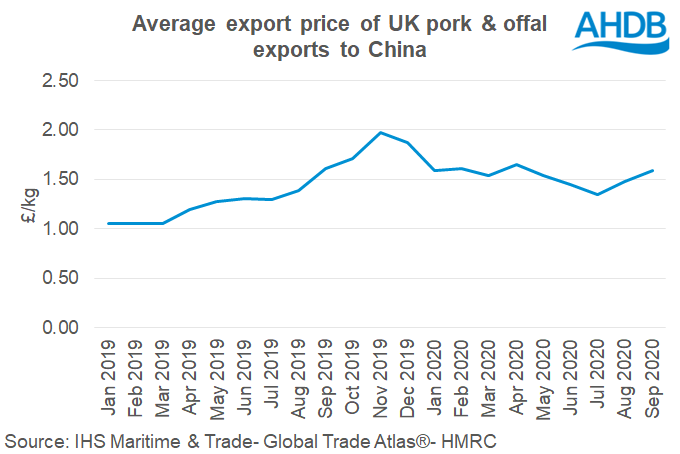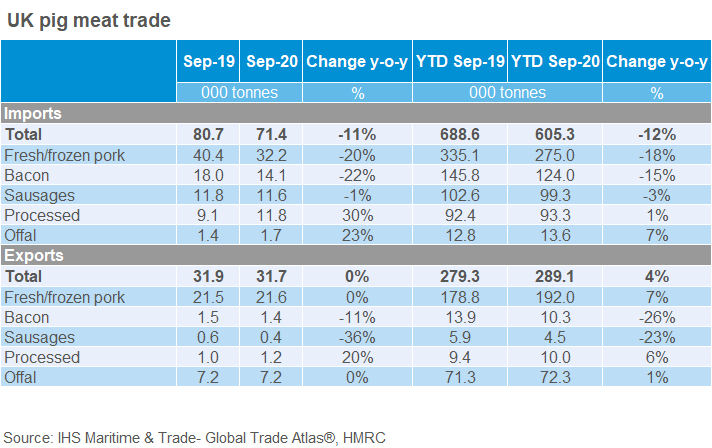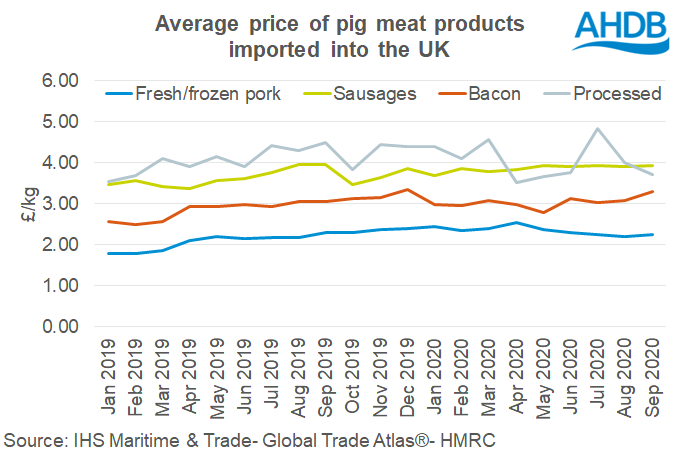UK pig meat exports hold steady in September
Thursday, 26 November 2020
By Bethan Wilkins
UK pig meat exports continued a stable performance in September, with volumes holding steady on 2019 levels, which were 5% above 2018.
Looking at fresh/frozen pork specifically, volumes totalled 21,600 tonnes, slightly higher than both the previous month and September last year. Strong demand from China is still ongoing at the moment, which continues to present opportunities for UK exporters. Germany also lost China access in mid-September due to the ASF outbreak, which may have created some additional opportunities. Nonetheless, next year the outlook for this market is less buoyant.
China remains by far the leading destination; 43% of fresh/frozen pork exports were shipped there. Exports to a number of other important markets dropped back compared to last year. The Netherlands received significantly less pork, with September shipments about half of 2019 levels. Ireland was also sent 20% less UK pork than last September.
The average export price of product sent to China also posted some recovery in September, compared to previous months.

Offal exports also remained similar to year earlier levels. There was increasing demand from a number of destinations, including China and a number of EU markets, especially Belgium. However, this was counteracted by weak sales to the Netherlands.

The UK imported 8,300 less fresh/frozen pork this September than a year earlier, a similar decline to that seen earlier in the year. Most suppliers decreased shipments to the UK, the exceptions being Denmark, Portugal and Austria. Denmark remains by far the principal source. Imports of cured pig meat also fell sharply. Sausage imports continued to be less affected by the general declining trend.
Conversely, imports of processed pig meat increased on the back of more shipments from Poland and Ireland in particular. This was only partially offset by decreased trade with the Netherlands.
The average price of imported fresh/frozen pork does seem to have declined in recent months, but the picture is more varied for other products. Of course, the mix of products imported, which can vary, also influences these trends.

Sign up for regular updates
Subscribe to receive pork market news straight to your inbox. Simply complete our online form.
While AHDB seeks to ensure that the information contained on this webpage is accurate at the time of publication, no warranty is given in respect of the information and data provided. You are responsible for how you use the information. To the maximum extent permitted by law, AHDB accepts no liability for loss, damage or injury howsoever caused or suffered (including that caused by negligence) directly or indirectly in relation to the information or data provided in this publication.
All intellectual property rights in the information and data on this webpage belong to or are licensed by AHDB. You are authorised to use such information for your internal business purposes only and you must not provide this information to any other third parties, including further publication of the information, or for commercial gain in any way whatsoever without the prior written permission of AHDB for each third party disclosure, publication or commercial arrangement. For more information, please see our Terms of Use and Privacy Notice or contact the Director of Corporate Affairs at info@ahdb.org.uk © Agriculture and Horticulture Development Board. All rights reserved.

